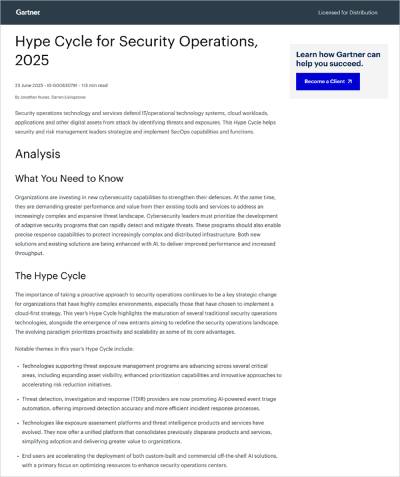
-min.webp)
The frequency and severity of data breaches is a constant reminder that a well-equipped Security Operations Center (SOC) is vital for protecting organizations from cyber threats. With the right security operations center tools, SOCs can efficiently monitor, detect, and respond to potential incidents, thereby enhancing overall security operations. Leveraging advanced SOC tools, or SecOps tools, ensures that security teams can stay ahead of threats, minimize risks, and maintain a robust security posture. From endpoint detection to automated response, these tools are essential for a comprehensive defense strategy.
To help you navigate the complex world of SOC tools, we will explore key categories and top vendors in each area, highlighting their primary benefits and potential drawbacks.
Overview: Endpoint Detection and Response (EDR) tools are designed to monitor end-user devices (endpoints) to detect and respond to cyber threats. These tools provide out of the box detection logic, visibility into raw endpoint telemetry to perform investigations, and empower users to contain hosts, ban files, and kill processes and network connections. As a security team, this should be among the first tools you consider in your arsenal.
Top Vendors:
Benefits:
Drawbacks:
{{ebook-cta}}
Overview: Security Information and Event Management (SIEM) systems collect and analyze log data from various sources within an organization’s IT infrastructure. They provide centralized visibility, enabling the detection of security incidents through correlation and analysis of logged events. In some cases, organizations may just need to have logging information retained, but not readily available for search – which can be significantly less expensive.
Key sources may include network traffic/flow logs, VPN and multifactor authentication logs, DHCP logs, custom application logging, and any data needed for compliance retention.
Top Vendors:
Benefits:
Drawbacks:
Overview: Cloud Security Posture Management (CSPM) tools help organizations manage and ensure the security compliance of their cloud environments. These tools continuously monitor cloud infrastructure for misconfigurations, compliance risks, and security vulnerabilities. The leading initial access vector for ransomware operators has been public vulnerability exploitation, so identification and response to known vulnerability has become increasingly important for security teams.
Top Vendors:
Benefits:
Drawbacks:
Overview: Cloud Detection and Response (CDR) tools are focused on detecting and responding to threats within cloud environments. They provide visibility into cloud-native activities and detect suspicious behaviors specific to cloud infrastructure. Given most security teams' lack of general cloud-native experience, having dedicated tooling to bootstrap your team and make threat identification easier is crucial, allowing your team to effectively safeguard your cloud environment without needing extensive cloud expertise.
Top Vendors:
Benefits:
Drawbacks:
Overview: Response Automation tools streamline and automate the response to security incidents, reducing the time and effort required for manual interventions. These tools can automate repetitive tasks, orchestrate complex workflows, and ensure consistent response actions.
Top Vendors:
Benefits:
Drawbacks:
The most time-consuming part of a SOC’s workflow is investigating the constant stream of alerts generated across tools. AI SOC platforms like Prophet AI automate this process by acting as an agentic analyst: investigating alerts, asking the right lines of questioning, and delivering clear, explainable determinations. This goes far beyond static playbooks or enrichment dashboards — it’s dynamic reasoning at machine speed.
Our Benefits:
Discover how Prophet Security can lower your risk and boost Security Operations productivity by streamlining alert triage and investigation, freeing up your team to focus on more impactful tasks. Request a demo of Prophet AI to learn how you can triage and investigate security alerts 10 times faster.
A Security Operations Center, or SOC, is a centralized function that monitors, detects, investigates, and responds to cyber threats across an organization’s IT infrastructure. SOCs play a critical role in reducing risks by providing 24/7 visibility and rapid response to incidents.
Essential SOC tools include Endpoint Detection and Response (EDR) platforms, Security Information and Event Management (SIEM) systems, Cloud Security Posture Management (CSPM) tools, Cloud Detection and Response (CDR) solutions, and response automation platforms. Together, these tools enable comprehensive monitoring, investigation, and response capabilities.
An AI SOC platform leverages agentic AI to automate alert investigation and triage, simulating the reasoning process of a human analyst. This reduces manual workloads, accelerates investigations, and improves the consistency of outcomes by combining large language models with security-specific logic.
An AI SOC platform improves SOC efficiency by automating the investigative process, reducing alert dwell time, and freeing analysts from repetitive triage tasks. This allows teams to focus on higher-value work like threat hunting and detection tuning, ultimately improving security outcomes.
AI SOC platforms like Prophet AI integrate directly into existing SOC workflows through tools like Slack, JIRA, and ServiceNow. This allows analysts to receive investigative insights and make decisions without disrupting established processes.
An AI SOC platform can significantly reduce mean time to investigate (MTTI) and mean time to resolve (MTTR) by automating the bulk of alert triage and investigation. Organizations often see a 5x–10x improvement in investigation speed, along with reduced operational costs.
Unlike traditional SOAR platforms that rely on static playbooks and manual configuration, AI SOC platforms use dynamic, reasoning-driven automation to investigate and resolve alerts. This makes them more adaptable and capable of handling complex, evolving security incidents.
Organizations should assess the platform’s integration quality with their existing tools, its ability to provide explainable decisions, its handling of sensitive data, and its adaptability to custom detections and organization-specific context.
Discover how AI SOC Agents and other technologies are reshaping security operations

